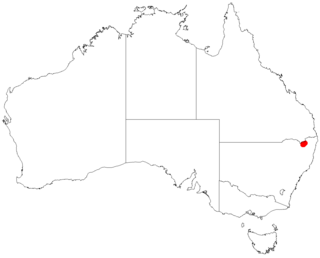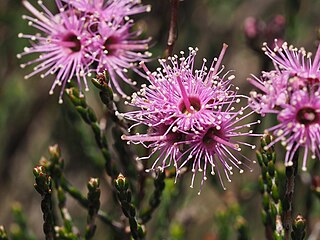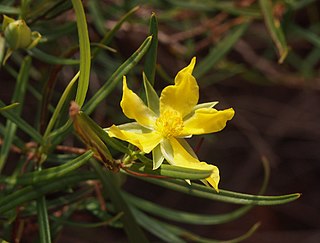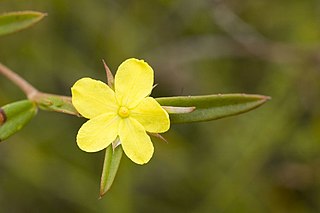
Olearia axillaris, commonly known as coastal daisy-bush, coast daisy-bush or coastal daisybush is a species of flowering plant in the family Asteraceae and is endemic to coastal areas of Australia. It is an erect, bushy shrub with densely cottony-hairy branchlets, aromatic, linear to narrowly elliptic or narrowly lance-shaped to egg-shaped leaves with the narrower end towards the base and small white and yellow, daisy-like inflorescences.

Vesselowskya rubifolia, commonly known as southern marara, red ash, mountain marara or Dorrigo southern marara, is a species of flowering plant in the family Cunoniaceae plant and has a restricted distribution in eastern New South Wales. It is a shrub or small tree with compound leaves with three or five leaflets with serrated edges, and small whitish flowers arranged along a raceme.

Darwinia micropetala, commonly known as small darwinia, is a species of flowering plant in the family Myrtaceae and is endemic to south-eastern continental Australia. It is a small, erect shrub with linear leaves, and heads of white to pink flowers.

Persoonia arborea, commonly known as tree geebung, is a species of large shrub or small tree that is endemic to Victoria, Australia.

Pimelea congesta is a species of flowering plant in the family Thymelaeaceae and is endemic to Lord Howe Island in Australia. It is a shrub with rough bark, decussate, elliptic leaves and heads of white flowers.

Melaleuca eleuterostachya is a plant in the myrtle family, Myrtaceae and is endemic to Western Australia and South Australia. It is a shrub or tree with arching branches, narrow leaves and small spikes of cream or white flowers.

Cassinia compacta is a species of flowering plant in the family Asteraceae and is endemic to eastern Australia. It is a shrub with densely hairy stems, linear leaves and heads of yellow flowers arranged in dense corymbs.
Persoonia brachystylis is a species of flowering plant in the family Proteaceae and is endemic to a restricted area on the west coast of Western Australia. It is an erect, spreading shrub with smooth bark, narrow spatula-shaped to lance-shaped leaves and yellow flowers in groups of ten to twenty.

Prostanthera staurophylla, commonly known as Tenterfield mint-bush, is a species of flowering plant in the family Lamiaceae and is endemic to a small area on the New England Tableland of New South Wales. It is an erect to spreading, strongly aromatic shrub with hairy branches, deeply lobed leaves and bluish-mauve flowers with darker markings.
Kunzea calida is a plant in the myrtle family, Myrtaceae and is endemic to Queensland, Australia. It is a spreading shrub which has linear to lance-shaped leaves but which are rolled, making them appear cylindrical. The flowers are pinkish-purple and arranged in groups near the ends of the branches in September. It is only known in remote and rugged areas of the Mount Stewart Ranges near Homestead.

Kunzea opposita is a plant in the myrtle family, Myrtaceae and is endemic to eastern Australia. It is a spindly shrub which has small leaves arranged in opposite pairs, and pink flowers with five petals and many stamens, the stamens much longer than the petals. It usually grows in woodland or on exposed cliffs.

Leptospermum arachnoides, commonly known as the spidery tea-tree, is a species of shrub that is endemic to eastern Australia. It has rough bark, crowded linear to lance-shaped leaves with a sharp point on the end, white flowers and hairy fruit.

Leptospermum coriaceum, commonly known as green tea-tree or mallee teatree, is a shrub species that is endemic to south-eastern Australia. It has smooth bark on the younger stems, elliptic to narrow egg-shaped leaves, white flowers and woody fruit. The usual habitat is mallee on sand dunes.

Leptospermum brevipes, commonly known as the slender tea-tree, is a species of shrub or small tree that is endemic to eastern Australia. It has fibrous bark on the main stems, smooth bark on young stems, narrow elliptical to narrow egg-shaped leaves, white flowers and hemispherical fruit that is shed when mature.

Rhadinothamnus euphemiae, is a slender, small, upright shrub with needle-shaped branchlets thickly covered with silvery scales and tubular greenish-purple tubular flowers throughout the year. It is endemic to the south coast of Western Australia.

Melicope vitiflora, commonly known as northern evodia, fishpoison wood, leatherjacket or leatherwood, is a species of shrub or small tree in the family Rutaceae and is native to north-eastern Australia and New Guinea. It has trifoliate leaves and green to white or cream-coloured flowers borne in panicles in leaf axils.
Thryptomene ericaea is a species of flowering plant in the family Myrtaceae and is endemic to South Australia. It is a shrub with narrow elliptic leaves and white flowers with five petals and five stamens.

Hibbertia glaberrima is a species of flowering plant in the family Dilleniaceae and is endemic to Central Australia. It is a glabrous, spreading shrub with oblong to lance-shaped leaves and yellow flowers borne singly in upper leaf axils, with 30 to 150 stamens arranged around three carpels.
Hibbertia goyderi is a species of flowering plant in the family Dilleniaceae and is endemic to the Northern Territory. It is a small leafless shrub with angular stems and yellow flowers with about nine or ten stamens arranged around the two carpels.

Hibbertia salicifolia is a species of flowering plant in the family Dilleniaceae and is endemic to eastern Australia. It is a shrub with loose reddish bark, linear to oblong leaves and yellow flowers with the stamens arranged all around the carpels.

















